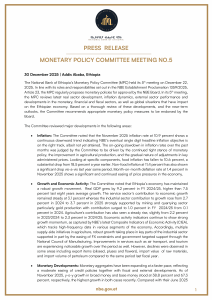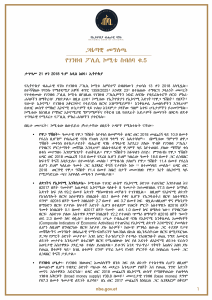9 July 2024 | Addis Ababa, Ethiopia
As part of its primary goal of ensuring low and stable inflation, the NBE has been working towards the modernization of Ethiopia’s monetary policy framework over the past year. Several preparatory measures have been taken, in line with the NBE Medium-term Strategy Plan, to establish a supportive legal, institutional, and technical basis for meeting this objective. Most notably, the NBE’s mandate has been clearly defined to prioritize price stability relative to other goals. In addition, NBE’s technical capacity has been enhanced so as to adopt monetary policy tools that are better in line with modern central bank practices and more consistent with an increasingly dynamic and market-based financial system.
With the above preparatory work now largely complete, the NBE is today announcing the following set of measures to fully implement its new monetary policy framework.
- First, NBE is moving to an interest-rate based monetary policy regime. Under the new policy framework, NBE will use its policy interest rate—to be known as the National Bank Rate or NBR—as the primary means of signaling its policy stance and influencing broader monetary and credit conditions. The NBR will be raised or lowered depending on prevailing inflationary and monetary conditions.
- Second, the NBE is setting its initial policy interest rate at 15 percent. This policy rate takes into account current macroeconomic conditions, which are characterized by gradually declining (but still elevated) inflation, low base money growth, and a marked slowdown of bank credit growth over the past year. The policy rate is close to the rate at which banks currently lend to each other and is somewhat below commercial bank lending rates, which are in the range of 16-20 percent for most loan categories. The NBR is not meant to fix or set interest rates in the banking sector, which remain determined by the competitive interactions among banks and their clients. The minimum savings rate of 7 percent is not affected or currently being changed by the introduction of the NBE policy rate.
- Third, the NBE will start conducting monetary policy related auctions every two weeks, whereby it will either withdraw or supply liquidity to the banking system depending on its assessment of the latest prevailing conditions. These auctions, known formally as Open Market Operations, will be used as the primary monetary policy instrument to ensure that interest rates in the interbank market—the operating target of monetary policy—remain close to the NBR. When excess liquidity in the banking system leads to significant downward deviations in the interbank market rate from the NBR, the OMO auctions will be used to withdraw excess liquidity from the banking system. Conversely, when the banking system as a whole is short of liquid funds resulting in significant upward deviations of the interbank market rate from the NBR, NBE will use OMO auctions to inject liquidity into the banking system. The first OMO auction is scheduled for July 11, 2024.
- Fourth, NBE is also introducing an ‘Overnight Lending Facility’ and an ‘Overnight Deposit Facility’ for banks that might need to manage their liquidity positions over just a one-day time horizon. These facilities, known formally as Standing Facilities, will be offered at the NBR rate plus or minus 3 percent.
- Fifth, NBE is soon introducing an electronic platform that will make it easier for banks to lend to and borrow from each other, thereby facilitating an active and functional ‘interbank money market’. The money market, once fully operationalized via a web-based online platform, will allow liquidity-surplus banks to provide funds to liquidity-short banks on a continuous basis, thereby allowing shortage or surplus conditions at specific banks to be addressed within the banking system and without the need for central bank intervention. It is expected that interest rates in the interbank market will align with the NBR but, should this not be the case, the NBE will intervene using OMO auctions (as outlined earlier) to ensure that the interbank interest rate converges to the NBR.
- Sixth, as the shift to the new monetary policy framework is taking effect, the NBE will for a transitory period retain its past tools for managing liquidity. More specifically, quantitative measures for monetary management may be used as supplementary tools should the new monetary transmission mechanisms (whereby changes in the policy rate affect economy-wide credit conditions) turn out to be weaker or slower than initially expected. In addition, specific monetary policy instruments for addressing interest-free banking providers will be specified by the NBE in the near future.
Conclusion
The reforms being announced today represent a historic step in modernizing NBE’s monetary policy framework and aligning its policy tools with global best practices. The setting of a benchmark policy rate, the start of Open Market Operation auctions, the introduction of overnight facilities for banks, and the addition of a money market platform in the very near future are all important initiatives to support NBE in fulfilling the vital set responsibilities—most notably that of ensuring price stability—entrusted upon it per its own Strategy Plan and NBE Establishment Proclamation.
NBE believes that today’s package of measures will address some long-standing weaknesses in Ethiopia’s macroeconomic and banking environments. For the mutual benefit of all involved, NBE urges the cooperation of all stakeholders to ensure a successful implementation of this new monetary policy package.



